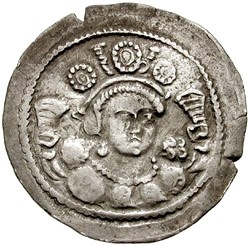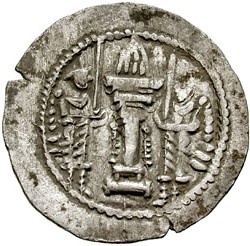Kidarite Kingdom Drachm - Kidara (Sassanian style, type 11A, Gandhara)
Introduction
The Kidarite Kingdom Drachm coin stands as a testament to the rich numismatic history of the ancient world. Struck between 350 and 400 AD, this silver coin showcases the influence of Sassanian art in the Gandhara region, combining elements of local culture with imperial imagery.
Historical Background
The Kidarite Kingdom, also known as the "Little Kushans," rose to power in Central Asia, controlling vast territories and trade routes. The issuance of the Drachm coin was a strategic move to assert authority and facilitate commerce within the realm. These coins circulated widely, serving as a symbol of the kingdom's economic prosperity.
Coin Images
 Obverse
Obverse
 Reverse
Reverse
Design Features
The obverse of the Drachm coin features a striking facing bust of the king, subtly turning to the right. The monarch wears a majestic crown adorned with streamers and three rosettes, symbolizing power and divine right to rule. This depiction reflects the fusion of Sassanian and local artistic styles, creating a visually captivating piece for collectors. On the reverse side, a prominent fire altar takes center stage, flanked by attendants in ceremonial attire. The fire altar symbolizes Zoroastrian religious beliefs, highlighting the spiritual significance of fire in ancient Persian culture. The attendants add a touch of realism to the design, showcasing the attention to detail in minting these coins.
Technical Specifications
This Drachm coin weighs approximately 3.24 grams and is crafted from high-quality silver, reflecting the skilled craftsmanship of the Kidarite minting authorities. With a diameter of X mm, this coin is of standard size for the era, making it easy to handle and store for collectors and traders alike.
Collectible Value
The Kidarite Kingdom Drachm coin holds significant value in the numismatic world due to its historical importance and unique design elements. Collectors prize these coins for their rarity and connection to a lesser-known period in ancient history. The market value of these coins can vary based on condition, provenance, and demand from collectors seeking to expand their ancient coin collections.
Conclusion
In conclusion, the Kidarite Kingdom Drachm coin represents a fascinating blend of cultures and ideologies, encapsulated in a small but intricately designed piece of silver. Its historical significance, coupled with its aesthetic appeal, makes it a prized possession for numismatists and history enthusiasts alike. By owning a piece of this ancient coinage, collectors can delve into the past and appreciate the artistry and symbolism of the Kidarite Kingdom.

